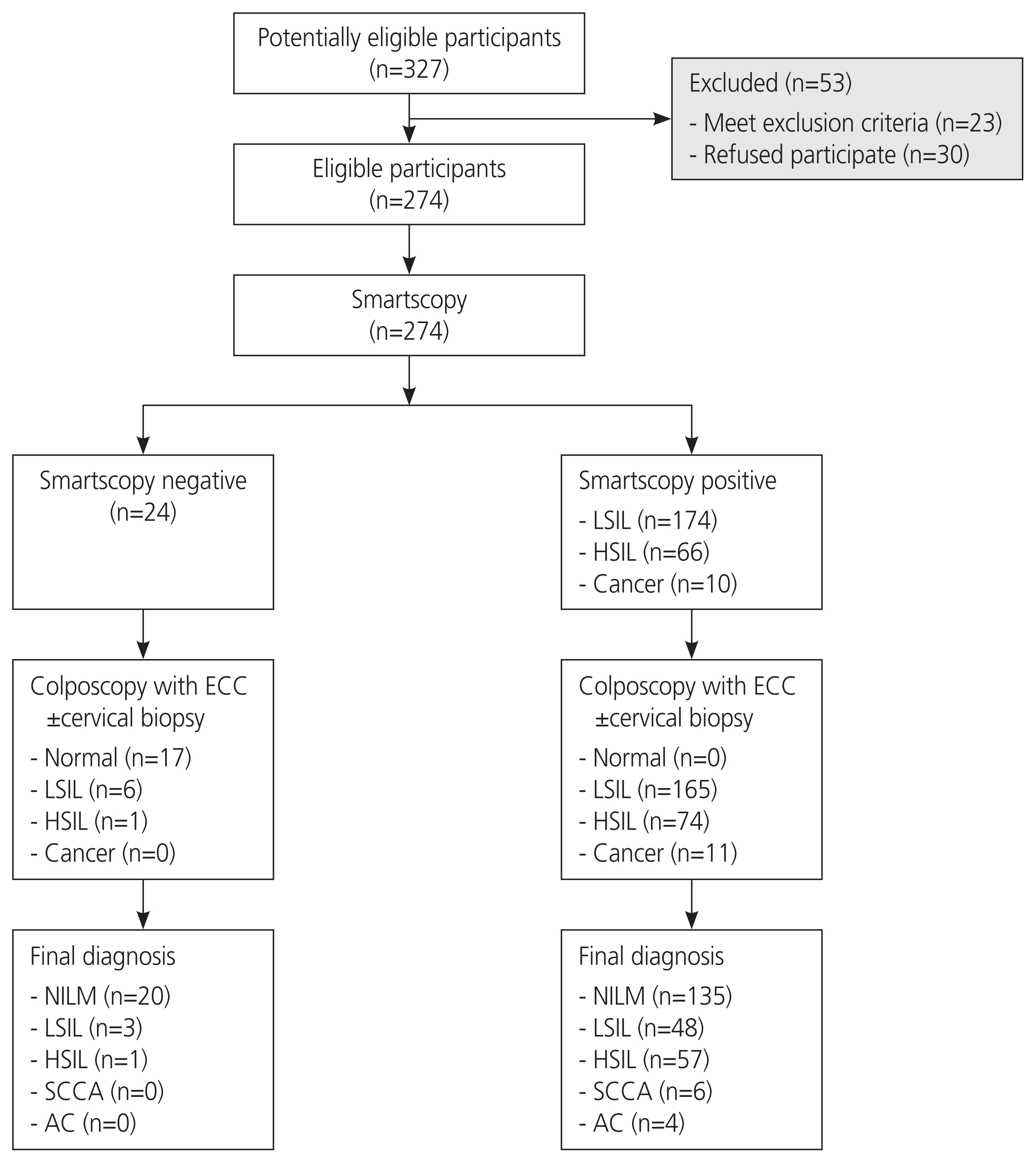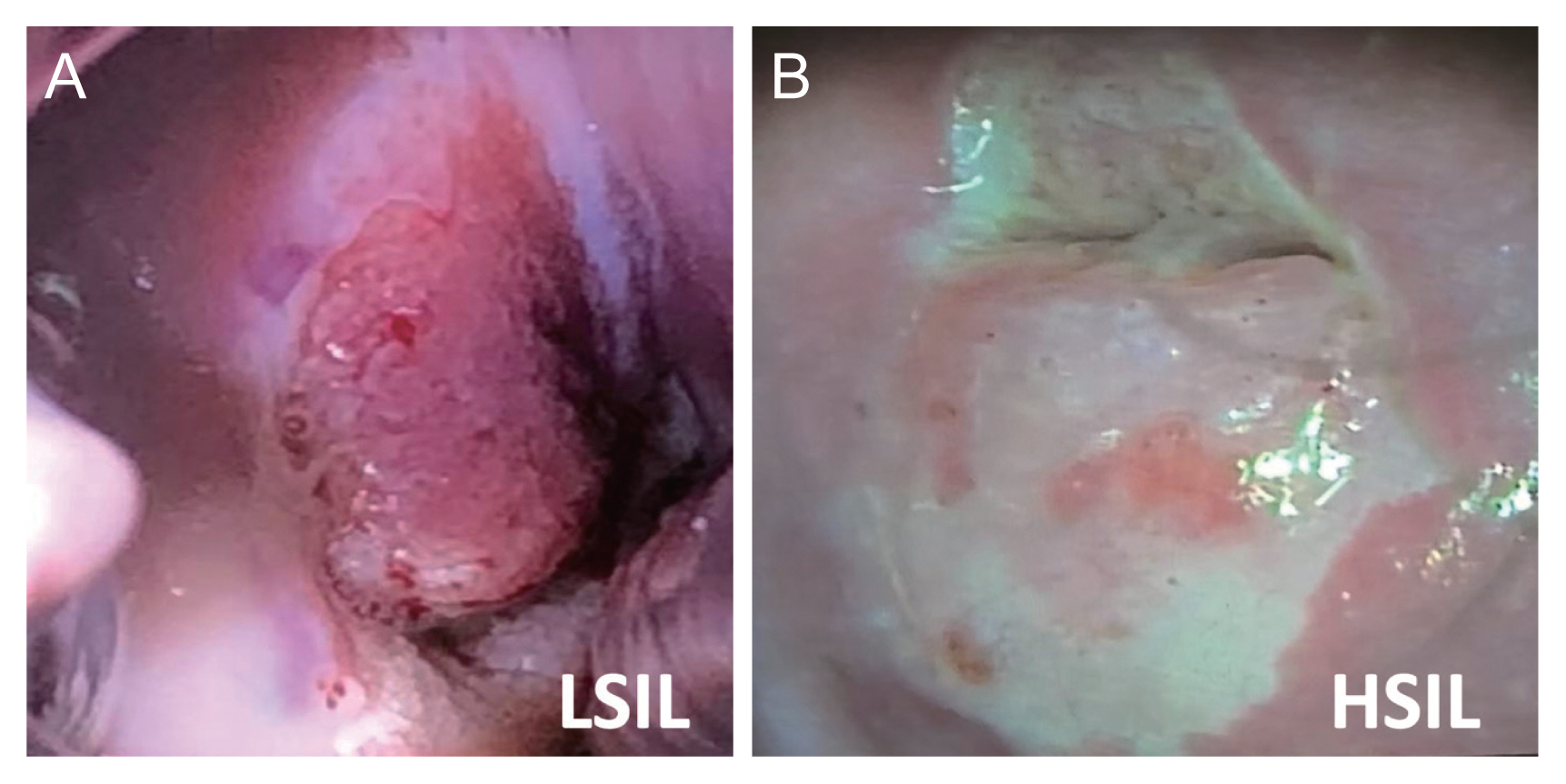Obstet Gynecol Sci.
2022 Sep;65(5):451-458. 10.5468/ogs.22092.
Predictive value of ‘Smartscopy’ for the detection of preinvasive cervical lesions during the COVID-19 pandemic: a diagnostic study
- Affiliations
-
- 1Department of Obstetrics and Gynecology, Faculty of Medicine, Khon Kaen University, Khon Kaen, Thailand
- KMID: 2533818
- DOI: http://doi.org/10.5468/ogs.22092
Abstract
Objective
To evaluate the performance of “Smartscopy” in diagnosing preinvasive cervical lesions among patients with abnormal cervical cancer screening results obtained during the coronavirus disease 2019 (COVID-19) pandemic.
Methods
This diagnostic study enrolled non-pregnant women with abnormal cervical cancer screening results obtained at the colposcopy clinic at Srinagarind Hospital (Khon Kaen, Thailand) between September 2020 and March 2021. Two colposcopists independently evaluated the uterine cervix using a smartphone and colposcopy. Cervical biopsies and endocervical curettage were performed in accordance with standard procedures. The diagnostic performance of a smartphone in detecting low-grade squamous intraepithelial lesions or worse plus (LSIL+) and high-grade squamous intraepithelial lesions plus (HSIL+) was assessed.
Results
In total, 247 patients were included. There was high agreement between the two colposcopists (κ=0.88; 95% confidence interval [CI], 0.82-0.93). The sensitivity, specificity, positive predictive value, negative predictive value, and accuracy of the smartphone to detect LSIL+ were 96.6% (95% CI, 91.6-99.1), 12.9% (95% CI, 8.06-19.2), 46.2% (95% CI, 39.7-52.4), 83.3% (95% CI, 62.6-95.3), and 0.49% (95% CI, 0.43-0.55), respectively. The sensitivity, specificity, positive predictive value, negative predictive value, and accuracy of smartscopy in diagnosing HSIL+ were 67.6% (95% CI, 55.2- 78.5), 85.4% (95% CI, 79.9-90.0), 60.5% (95% CI, 48.6-71.6), 88.9% (95% CI, 83.7-92.9), and 81.0% (95% CI, 0.75-0.85), respectively.
Conclusion
Smartscopy demonstrated a remarkable correlation with colposcopy and a high diagnostic performance value for the detection of preinvasive cervical lesions. Therefore, smartscopy may be an alternative tool for detecting abnormal cervical lesions in low to medium medical resource settings. Smartscopy may be applied in telemedicine during the COVID-19 pandemic.
Keyword
Figure
Cited by 1 articles
-
Diagnostic accuracy of hand-held colposcope (Gynocular) in comparison with standard colposcope in patients with abnormal cervical cytology or visual inspection with acetic acid positivity: a cross over randomized controlled study
Sowmiya Jayabalan, Murali Subbaiah, Latha Chaturvedula
Obstet Gynecol Sci. 2023;66(4):300-306. doi: 10.5468/ogs.23089.
Reference
-
References
1. Arbyn M, Weiderpass E, Bruni L, de Sanjosé S, Saraiya M, Ferlay J, et al. Estimates of incidence and mortality of cervical cancer in 2018: a worldwide analysis. Lancet Glob Health. 2020; 8:191–203.
Article2. Gaffney DK, Hashibe M, Kepka D, Maurer KA, Werner TL. Too many women are dying from cervix cancer: problems and solutions. Gynecol Oncol. 2018; 151:547–54.
Article3. Chrysostomou AC, Kostrikis LG. Methodologies of primary HPV testing currently applied for cervical cancer screening. Life (Basel). 2020; 10:290.
Article4. Chen W, Zheng R, Baade PD, Zhang S, Zeng H, Bray F, et al. Cancer statistics in China, 2015. CA Cancer J Clin. 2016; 66:115–32.
Article5. Bhatla N, Singhal S. Primary HPV screening for cervical cancer. Best Pract Res Clin Obstet Gynaecol. 2020; 65:98–108.
Article6. Cholli P, Bradford L, Manga S, Nulah K, Kiyang E, Manjuh F, et al. Screening for cervical cancer among HIV-positive and HIV-negative women in cameroon using simultaneous co-testing with careHPV DNA testing and visual inspection enhanced by digital cervicography: findings of initial screening and one-year follow-up. Gynecol Oncol. 2018; 148:118–25.
Article7. Mungo C, Ibrahim S, Bukusi EA, Truong HM, Cohen CR, Huchko M. Scaling up cervical cancer prevention in Western Kenya: treatment access following a community-based HPV testing approach. Int J Gynaecol Obstet. 2021; 152:60–7.8. Khan MJ, Werner CL, Darragh TM, Guido RS, Mathews C, Moscicki AB, et al. ASCCP colposcopy standards: role of colposcopy, benefits, potential harms, and terminology for colposcopic practice. J Low Genit Tract Dis. 2017; 21:223–9.
Article9. Barut MU, Kale A, Kuyumcuoğlu U, Bozkurt M, Ağaçayak E, Özekinci S, et al. Analysis of sensitivity, specificity, and positive and negative predictive values of smear and colposcopy in diagnosis of premalignant and malignant cervical lesions. Med Sci Monit. 2015; 21:3860–7.
Article10. Nam K. Colposcopy at a turning point. Obstet Gynecol Sci. 2018; 61:1–6.
Article11. Gallay C, Girardet A, Viviano M, Catarino R, Benski AC, Tran PL, et al. Cervical cancer screening in low-resource settings: a smartphone image application as an alternative to colposcopy. Int J Womens Health. 2017; 9:455–61.
Article12. Melbye S, Kessing LV, Bardram JE, Faurholt-Jepsen M. Smartphone-based self-monitoring, treatment, and automatically generated data in children, adolescents, and young adults with psychiatric disorders: systematic review. JMIR Ment Health. 2020; 7:e17453.
Article13. Anthony Bokolo Jnr. Use of telemedicine and virtual care for remote treatment in response to COVID-19 pandemic. J Med Syst. 2020; 44:132.
Article14. Tanaka Y, Ueda Y, Kakubari R, Kakuda M, Kubota S, Matsuzaki S, et al. Histologic correlation between smartphone and coloposcopic findings in patients with abnormal cervical cytology: experiences in a tertiary referral hospital. Am J Obstet Gynecol. 2019; 221:241e1–241.e6.
Article15. Catarino R, Vassilakos P, Scaringella S, Undurraga-Malinverno M, Meyer-Hamme U, Ricard-Gauthier D, et al. Smartphone use for cervical cancer screening in low-resource countries: a pilot study conducted in madagascar. PLoS One. 2015; 10:e0134309.
Article16. Tran PL, Benski C, Viviano M, Petignat P, Combescure C, Jinoro J, et al. Performance of smartphone-based digital images for cervical cancer screening in a low-resource context. Int J Technol Assess Health Care. 2018; 34:337–42.
Article17. Nayar R, Wilbur DC. The pap test and bethesda 2014. Cancer Cytopathol. 2015; 123:271–81.
Article18. Bornstein J, Bentley J, Bösze P, Girardi F, Haefner H, Menton M, et al. 2011 colposcopic terminology of the international federation for cervical pathology and colposcopy. Obstet Gynecol. 2012; 120:166–72.
Article19. Perkins RB, Guido RS, Castle PE, Chelmow D, Einstein MH, Garcia F, et al. 2019 ASCCP risk-based management consensus guidelines for abnormal cervical cancer screening tests and cancer precursors. J Low Genit Tract Dis. 2020; 24:102–31.20. Bomfim-Hyppólito S, Franco ES, Franco RG, de Albuquerque CM, Nunes GC. Cervicography as an adjunctive test to visual inspection with acetic acid in cervical cancer detection screening. Int J Gynaecol Obstet. 2006; 92:58–63.
Article21. Kim SN, Kim YH, Nam KH, Lee SK, Lee TS, Choi HS, et al. Development and validation of novel digitalized cervicography system. Obstet Gynecol Sci. 2016; 59:227–32.
Article22. Singhakum N, Laiwejpithaya S, Chaopotong P. Digital cervicography by simply portable device as an alternative test for cervical cancer screening in rural area of Thailand. Asian Pac J Cancer Prev. 2018; 19:1145–9.23. Sato M, Shintani D, Hanaoka M, Sato S, Miwa M, Ogasawara A, et al. A pilot study of mobile digital colposcopy in Japanese patients with cervical intraepithelial neoplasm. Mol Clin Oncol. 2021; 15:207.
Article
- Full Text Links
- Actions
-
Cited
- CITED
-
- Close
- Share
- Similar articles
-
- The COVID-19 pandemic's impact on prostate cancer screening and diagnosis in Korea
- The Management of Thyroid Disease in COVID-19 Pandemic
- Assessment and Management of Dysphagia during the COVID-19 Pandemic
- Tracheostomy in the Era of COVID-19 Pandemic
- The epidemiologic characteristics of dog-bite injury during COVID-19 pandemic in Korea



